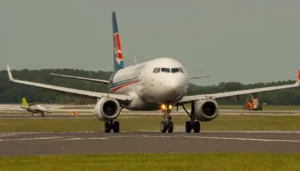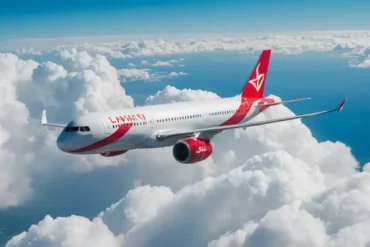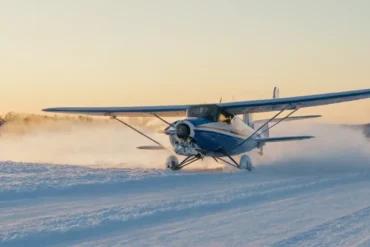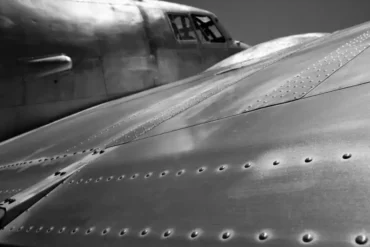Aircraft are designed primarily for efficient flight, with a focus on engine power and wing lift to optimize the in-air experience. But a flawless flying machine also needs to handle well on the ground! Moving from runway to terminal is a crucial task that requires skillful piloting. So how do pilots gracefully maneuver those gigantic 200-ton aircraft around airports?
Airport Layouts
Major international airports are like whole cities! Denver International Airport covers over 53 square miles – that’s even bigger than the footprints of Manhattan, San Francisco, or Miami. Amsterdam’s airport shows just how huge they can be; after landing, you may have to taxi for miles to reach the terminal. Meanwhile, crowded hubs like New York’s JFK deal with tight space, creating logistical challenges for ground movements.
Airfield Areas
Airfields have three main zones: ramps (aprons) where aircraft park, runways for takeoffs and landings, and taxiways connecting them. Runways are wide (about 45-60 meters) and vary in length; one at London Heathrow is nearly 4 kilometers long! With aircraft landing at weights up to 380 tons, runways withstand repeated impacts from the mighty Airbus A380. Proper drainage prevents rain from causing slippery conditions.
Taxiways differ in width and weight capacities, tailored to each airfield’s needs. Pilots must follow markers that designate suitable taxiways based on aircraft size. For instance, the Dreamliner’s 60+ meter wingspan requires vigilance to avoid scraping wingtips on turns. Larger aircraft add complexity to ground operations.
Moving Around the Airport
Parking stands are key spots for aircraft transitions between flights. They provide space for loading, unloading, and service vehicles when engines are off. At busy airports, a single stand may host two smaller aircraft when not occupied by a larger one.
Maneuvering Around
Here’s an interesting perspective: when you see an aircraft’s nose through the terminal window, the pilots are also preparing to depart right in front of you! But parking orientations, especially facing the terminal, create a challenge. Unlike cars, aircraft can’t reverse, so navigating backward from the stand is tricky. This is where pushback tugs come in handy!

Pushback Tugs: Powerful and Compact
Though small, pushback tugs pack a punch with their 60+ ton weight providing traction without wheel slips. At Munich Airport, tug operator Airside MUC handles aircraft up to 757s. Maneuvering takes finesse – they first attach to the aircraft’s tow-bar, then connect the tug. With steering linked to both the nose gear and tow-bar, close coordination makes the tug dance gracefully with the aircraft.
Aircraft Movement: Tugging That Heavy Weight
But tugs struggled when larger aircraft came along. Even a sturdy 60-ton model couldn’t prevent wheel spin on a 560-ton A380. The solution? Tow-barless tugs! By lifting and clamping onto the nose gear, they leverage the aircraft’s own weight for traction. “It takes 40-90 seconds to attach,” explains an operator. Tugs like the Goldhofer AST-1X, with its 16-liter 700 HP engine, can easily handle aircraft up to the A380.
On the Move
Once free of the tug and engines fired up, pilots radio the tower for taxi clearance to the runway. Designated taxiways with right-of-way rules guide them along. Smaller airports may have just one, while major airfields have an intricate network. Notably, aircraft only taxi on assigned taxiways, never on runways.
Unlike cars, thrust – not the wheels – propels aircraft forward. Pilots increase engine thrust to move, while wheels pivot underneath.
Turning Corners
With a 60-meter wingspan but just a 60-meter length, the 787-8 has a large blind spot up front. Seated 5 meters up, pilots contend with a 14-meter gap ahead. Precise steering prevents scrapes. Turning happens two ways: rudder pedals offer limited steering, mainly via tail rudder and brakes. The nosewheel tiller steers up to 70 degrees for tight turns around corners.
Stopping Safely: Aircraft Braking Systems
Brakes
Halting safely matters as much as starting motion. Each main gear wheel has a brake unit, usually hydraulic. The 787 Dreamliner uses electric brakes – less weight and easier to service! Extensive testing proves their robustness, even if two of the eight units fail.
The system has handy features: Autobrake provides automatic braking at a rate selected by pilots based on conditions. Upon touchdown, it evenly applies brakes for a smooth exit. Antiskid Protection uses sensors to detect skidding and reduce braking accordingly – crucial for slippery winter runways.
Navigating the Maze
Some airports have winding taxiways with dead ends or runway merges. Pilots must stay alert on the maze-like paths. To help, taxiways have alphanumeric names on maps.
Reaching the Final Spot: Precision Aircraft Parking

High-Tech Guidance
Modern jets get dynamic maps like your car’s GPS! This real-time display proves invaluable in poor visibility, enhancing spatial awareness and preventing mix-ups.
Parking Skill
The last few meters are the trickiest part of a flight. Precise positioning avoids complications like bridges not reaching doors or wingtip collisions with other aircraft. That’s where laser guidance shines!
Lasers for Accuracy
Each parking stand has a scanning system that identifies aircraft types and potential obstructions. As planes approach, pilots get directional guidance – alignment, distance to stop mark, etc. Should any obstacle like a rogue vehicle appear, it commands an immediate stop. That’s why keeping belts fastened until the signs are off is so important!
You’ve probably seen marshaling wands in movies – they’re real and crucial! The hand signals communicate vital parking instructions to pilots.
The Final Maneuvers
Mastering flight controls is critical, but precise ground handling matters too. From tug operators skillfully steering aircraft to pilots navigating intricate taxiways, flawless ramp-to-runway-to-ramp operations require adept coordination on the ground and in the air.
Safety also means keeping seat belts fastened until parked, as things like catering trucks can warrant sudden stops. Smooth flying and ground handling make for an all-around enjoyable journey!


















